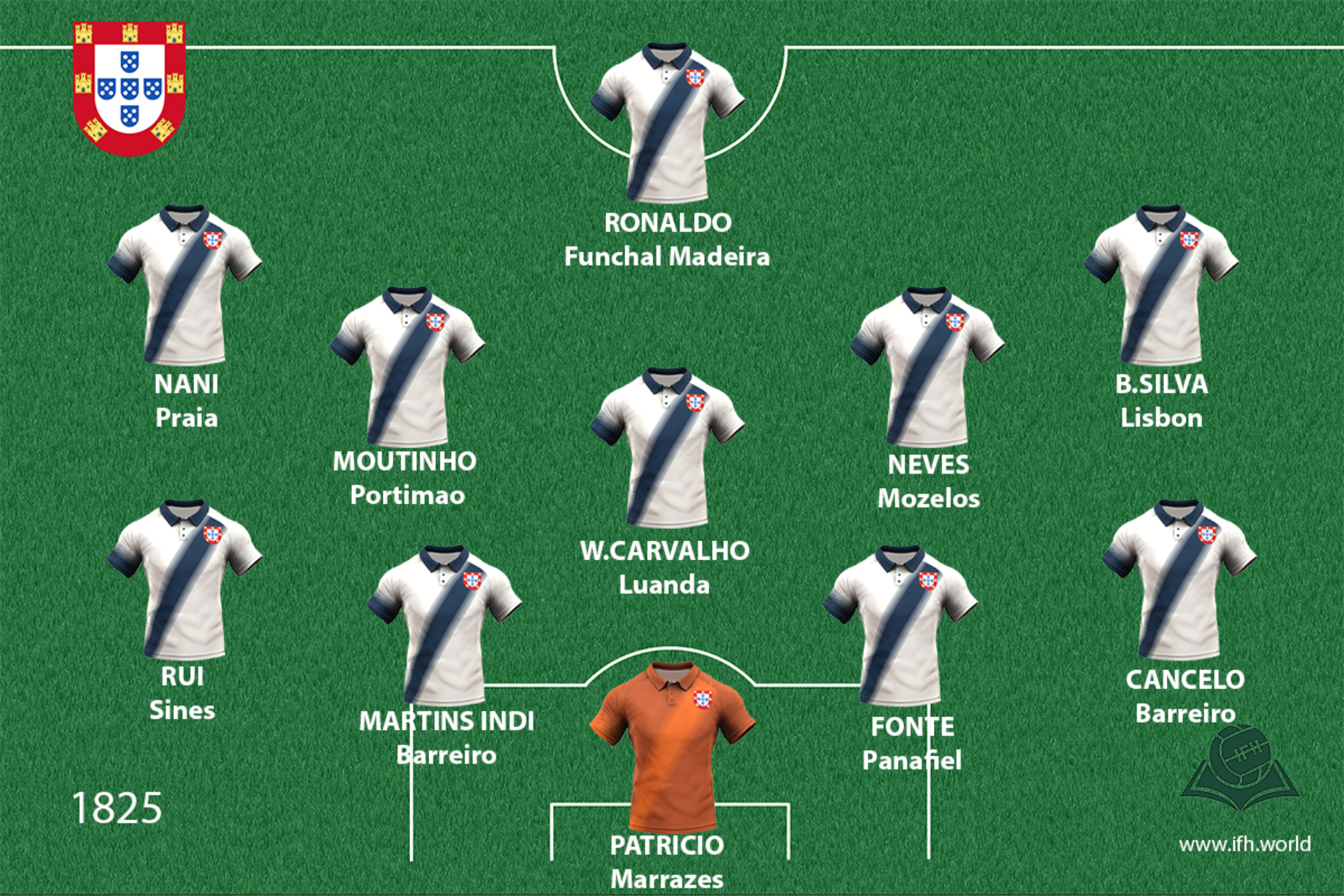Portuguese Empire
Back in the second half of the 18th century, the wealth of Portugal began to fade after the horrible earthquake that struck Lisbon (1755). Simultaneously, the country was under the protection of Great Britain.

Coat of arms

Shirt
| Position | First name | Last name | Mjesto rođenja | Like | Dislike | |
|---|---|---|---|---|---|---|
| GK | Jose | SA | Braga |
4 |
0 |
|
| GK | Rui | PATRICIO | Marrazes |
5 |
0 |
|
| DC | Bruno | ALVES | Póvoa de Varzim |
7 |
0 |
|
| DC | Jose | FONTE | Panafiel |
5 |
0 |
|
| DC | Paulo | OLIVEIRA | Vila Nova de Famalicão |
3 |
0 |
|
| DC | Ruben | DIAS | Amadora |
0 |
0 |
|
| DLC | Bruno | MARTINS INDI | Barreiro |
7 |
3 |
|
| DLC | Mario | RUI | Sines |
0 |
0 |
|
| DRL | Ricardo | PEREIRA | Lisbon |
1 |
0 |
|
| DRL/MR | Nelson | SEMEDO | Lisbon |
7 |
0 |
|
| DR/MR | Joao | CANCELO | Setubal |
2 |
1 |
|
| DL | Fabio | COENTRAO | Vila do Conde |
9 |
0 |
|
| DL | Vitorino | ANTUNES | Freamunde |
1 |
0 |
|
| DMC | Miguel | VELOSO | Coimbra |
6 |
0 |
|
| DMC | Ruben | NEVES | Mozelos |
3 |
0 |
|
| DMC | William | CARVALHO | Luanda |
1 |
0 |
|
| MC | Andre | GOMES | Vila Nova de Gaia |
7 |
1 |
|
| MC | Bruno | FERNANDES | Maia |
4 |
0 |
|
| MC | Joao | MOUTINHO | Portimao |
6 |
0 |
|
| MC | Renato | SANCHES | LISBON |
10 |
3 |
|
| MRLC | Joao | MARIO | Porto |
10 |
0 |
|
| AMRLC | Bernardo | SILVA | Lisbon |
11 |
0 |
|
| AMRLC | Luís Miguel Afonso Fernandes | PIZZI | Bragança |
3 |
0 |
|
| AMRL | Gelson | MERTENS | Praia |
0 |
0 |
|
| AMRL | Gonacalo | GUEDES | Benavente |
8 |
0 |
|
| AMRL | Luís Carlos Almeida da Cunha | NANI | Praia |
0 |
0 |
|
| AMRL | Rafa | SILVA | Vila Franca de Xira |
3 |
0 |
|
| AMRL | Ricardo | QUARESMA | Lisbon |
6 |
0 |
|
| SS/AMRL | Daniel | PODENCE | Oeiras |
2 |
0 |
|
| SS/FRLC | Diego | JOTA | Massarelos |
3 |
0 |
|
| FRLC | Cristiano | RONALDO | Funchal Madeira |
10 |
0 |
|
| FC/SS | Andre | SILVA | Baguim do Monte |
8 |
0 |
(Today part of: Portugal , Angola, Mozambique)
In exchange for weapons, mercenaries and protection of convoys that transported gold from Brazil, the Portuguese supplied Great Britain with wine, gave them a market for woolen fabrics, secure havens in waterways outside Europe and acted as their allies against Castile. Even after banishing Napoleon’s army the British kept economically and politically using the incompetent regency and practically governed Portugal as one of their colonies. A revolution came after a country-wide successful uprising against British government and the cession of the throne of Portugal to Maria II (1826 – 1853), the underage daughter of the king, whose brother was crowned king of independent Brazil in 1822. This revolution would, in the next thirty years, go through phases of constitutional radicalism reactionary repression, civil war, national uprising and urban terror. Forty governments came and went during this period.
With British economical support, the final victory was achieved by the liberal and mercantile south that sided with the queen. Thus, the revolution of the reactionary forces failed without involvement of the Holy Alliance, that considered Portugal of lesser importance. Portugal thoroughly changed: leaders dissolved monasteries, distributed church lands, sold crown estates, established new aristocratic titles, and created a parliamentary system, with the right of vote limited by property owned.
Sources
- David BIRMINGHAM, Povijest Portugala, Zagreb, 2004.
- Felipe FERNANDEZ-ARMESTO, Narodi Europe, Zagreb, 1997.
- Grupa autora, Povijest: Napoleon, restauracija i građanske revolucije (1800. - 1848.), knjiga XIII., Zagreb 2008.
- Coat of amrs, https://en.wikipedia.org/wiki/Coat_of_arms_of_Portugal
